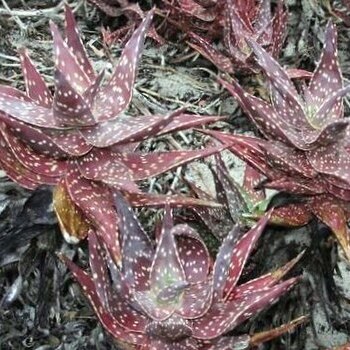Plants decumbent, 150-400 mm tall, leaves present in apical 200-300 mm of stems. Leaves ±20 per stem, broadly deltoid, 120-200 x 35-60 mm, bluish green with scattered white spots, keels rarely dentate. Inflorescence a simple to twice-branched, very dense, capitate raceme, up to 500 mm tall; peduncle with few sterile bracts; bracts ovate, 9-11 x 3-5 mm, 5-nerved. Flowers orange-red, 30-40 mm long; outer segments free for + half their length, inner segments free but adhering to outer for ± half their length; pedicels 35-50 mm long. Anthers exserted up to 3 mm. Ovary 7-8 x 2-3 mm; style exserted up to 6 mm. Fruit not seen.
Succulent shrublet with creeping stems to 1 m, simple or branched, with persistent dried leaves. Leaves blue-green, with copious white, irregularly scattered, oblong spots on both surfaces, lanceolate-attenuate, to 20 cm long; margins whitish, with tiny teeth. Racemes capitate, subcorymbose, dense, simple or occasionally branched, to 50 cm long. Flowers red, paler toward mouth, 40 mm long; stamens and stigma exserted.
Dense, medium-sized shrub, 150-400 mm tall. Stems numerous, creeping, leafy portions always erect. Leaves blue-green, fairly narrow, up to 200 mm long, copiously white-spotted on both surfaces, upturned, quite densely arranged in terminal rosettes, margins with whitish edges and very small teeth. Flowers in tightly packed, rarely branched, capitate panicles, pale red. (In north) July-Dec. (in south).

